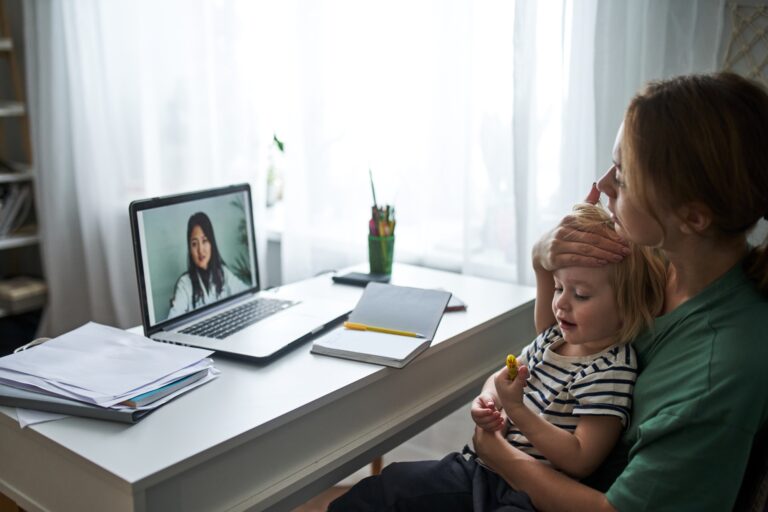For cancer patients, telehealth restrictions are a matter of life and death

In 2012, 18-month-old Jun Abell loved walking around his New York house and climbing the stairs. Then one day, his parents noticed that the toddler wasn’t walking at all.
Jun’s parents were concerned by his unusual behavior. Doctors couldn’t find any physical signs of injury or distress, but just to be safe, an MRI was ordered. The scans revealed that Jun had hydrocephalus, which happens when a tumor causes the cerebral spinal fluid to back up, putting pressure on the brain.
The toddler was rushed into surgery to treat the hydrocephalus on a Friday. By Monday, he had another surgery to remove as much of the tumor as possible.
After the initial shock of having their child rushed into two surgeries, it was time for Jun’s parents to create a treatment plan.
This was their first experience with cancer. They immediately dove into research, calling pediatric cancer specialists all over the country, even sending Jun’s MRI scans to different doctors to ask about treatment plans.
As shocked as they were, Jun’s parents were overwhelmed with the care doctors took in their son’s diagnosis.
Mike Abell, Jun’s father, remarked, “What’s amazing about this community of doctors in pediatric cancer is they all pick up the phone, they all answer, they all call you back.”
After the calls, the Abells realized that living in New York put them at great advantage, at least for the first part of Jun’s treatment: They had top-tier cancer treatment options available without having to travel. In New York, Jun had six rounds of high-dose chemo, three with stem cell replacement. The doctors were able to remove about 99% of the tumor during the first surgery. During the second surgery, they got about 99% of what was left. After the treatment ended, some of the tumor remained and Jun was approved to try proton radiation.
Typically, doctors will not use radiation to treat a child that young. But proton radiation is different. It allows for pinpoint accuracy. The only problem was, there were only a few hospitals using this type of treatment. One of these hospitals is Massachusetts General in Boston, where Dr. Shannon MacDonald is one of the most experienced doctors with proton radiation.
The family was able to meet initially with Dr. MacDonald via telehealth and arrange Jun’s treatment plan. There was a lot of fear going into the proton radiation, but Dr. MacDonald was always willing to take Jun’s parents’ phone calls to ease their fears as much as possible. Mike remembers, “We had several phone calls beforehand. She’d walk us through everything and yeah, just try to explain everything to our non-science minds.”
Jun and his family eventually relocated to Boston for his six weeks of treatment. After the family returned home, Dr. MacDonald conducted regular follow-up visits via telehealth. He is now 13 and living the life of a normal teenager in New Jersey, where his family now lives. But he will still have to get scans once a year to make sure the cancer has not returned.
Cancer patients and their loved ones are all too familiar with “scan-xiety,” the nervousness associated with waiting for the results of annual scans. Jun’s family took some comfort in knowing that if the unthinkable happens, Dr. MacDonald would be just a phone call away to help them figure out their next steps.
But that comfort has been taken from them. In the State of New Jersey, it is now illegal for the Abell family to meet with Dr. MacDonald via telehealth.
Liberating telehealth… temporarily
Prior to the COVID-19 pandemic, most states prohibited telehealth appointments with doctors licensed out-of-state. But during COVID, telehealth restrictions were relaxed via emergency waiver, which gave people the freedom to see doctors in any state without having to leave their homes. New Jersey also created temporary licenses that were easy for out-of-state doctors to get. Those temporary programs have also mostly ended now.
Having access to a wide variety of care options was a lifeline for many patients who, just like Jun, were able to get care that wasn’t available in their state.
With COVID now in the rear-view mirror, the emergency waiver has expired and, with it, the freedom for a patient to choose their doctors.
The government cannot use licensing regulations to prevent children (and adults) from accessing specialty medical care, especially if their local doctors have less expertise or fewer resources. Doing so violates the Constitution’s Dormant Commerce Clause and its Privileges and Immunities Clause.
But there is also a First Amendment right at stake. It is not only immoral but also unconstitutional for the government to stifle the exchange of information between patients and their doctors.
There is absolutely no good reason for these laws to limit access to specialty care. As the use of interstate telehealth during COVID waivers demonstrated, both patients and doctors benefit when they’re allowed to have calls across state lines. Limiting a person’s choice in medical specialists benefits no one. On the contrary, it only serves to hurt patients like Jun, who are already burdened with fighting for their life.
Unfortunately, this problem isn’t isolated to New Jersey alone. With the emergency waivers now gone, there are 30 states preventing patients like Jun from having access to lifesaving treatment with doctors they choose.
Cutting a lifeline
What is particularly irksome for the Abells is that at the time of Jun’s treatment, the phone calls between Jun’s parents and their doctors were not considered “telehealth.” In fact, there really was no such thing as telehealth at all, which means there were no regulations preventing the family from communicating with Dr. MacDonald. With much of our world now virtual, telehealth is more defined and, unfortunately, more regulated.
Dr. MacDonald is frustrated that the government is making it not only illegal but criminal for her and her patients to utilize telehealth. It’s upsetting to her to hear stories from patients who have suffered because of telehealth restrictions, and especially those who now have to travel for care while they are in the fight of their lives.
“I had a patient who would travel alone without their spouse, because it was too expensive for them to both take time off from work and get childcare. She told me, ‘When I was doing telemedicine, if I got bad news, I had my husband by my side. Now I’ll get it alone in a clinic room.’”
Dr. MacDonald has had other patients who have had to resort to driving hours to cross state lines just so they can legally take a call from their doctor in another state. One woman learned she had a brain tumor as she sat alone in a coffee shop while her kids waited in the car so they couldn’t hear.
Keeping pre-pandemic telehealth regulations in place isn’t just archaic—it’s unnecessarily cruel to patients who are most in need of help.
Being forced to travel across state lines for every single doctor appointment is not only taxing on the body and mind of cancer patients, but also expensive. The last thing patients undergoing expensive treatments need is to take on additional financial burdens.
Dr. MacDonald and the Abell family have filed suit in New Jersey to protect their constitutional right to telehealth.
While Pacific Legal Foundation’s fight to protect telehealth starts with New Jersey, we won’t stop fighting until every person has access to the care they need, regardless of where they live.








